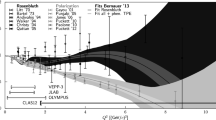Abstract
The proton elastic form factor ratio is accessible in unpolarized Rosenbluth-type experiments as well as experiments which make use of polarization degrees of freedom. The extracted values show a distinct discrepancy, growing with \(Q^2\). Three recent experiments tested the proposed explanation, two-photon exchange, by measuring the positron–proton to electron–proton cross section ratio. In the results, a hard two-photon exchange effect at the couple-of-percent level is visible, significantly different from theoretical calculation. Theory at larger momentum transfer remains untested. This paper discusses the possibilities for future measurements at larger momentum transfer.
Similar content being viewed by others
References
J. Litt et al., Phys. Lett. B 31, 40 (1970). https://doi.org/10.1016/0370-2693(70)90015-8
W. Bartel et al., Nucl. Phys. B 58, 429 (1973). https://doi.org/10.1016/0550-3213(73)90594-4
L. Andivahis et al., Phys. Rev. D 50, 5491 (1994). https://doi.org/10.1103/PhysRevD.50.5491
R.C. Walker et al., Phys. Rev. D 49(11), 5671 (1994). https://doi.org/10.1103/PhysRevD.49.5671
M.E. Christy et al., Phys. Rev. C 70(1), 015206 (2004). https://doi.org/10.1103/PhysRevC.70.015206
I.A. Qattan et al., Phys. Rev. Lett. 94(14), 142301 (2005). https://doi.org/10.1103/PhysRevLett.94.142301
O. Gayou et al., Phys. Rev. C 64(3), 038202 (2001). https://doi.org/10.1103/PhysRevC.64.038202
V. Punjabi et al., Phys. Rev. C 71(5), 055202 (2005). https://doi.org/10.1103/PhysRevC.71.055202
M.K. Jones et al., Phys. Rev. C 74, 035201 (2006). https://doi.org/10.1103/PhysRevC.74.035201
A.J.R. Puckett et al., Phys. Rev. Lett. 104, 242301 (2010). https://doi.org/10.1103/PhysRevLett.104.242301
M. Paolone et al., Phys. Rev. Lett. 105, 072001 (2010). https://doi.org/10.1103/PhysRevLett.105.072001
A.J.R. Puckett et al., Phys. Rev. C 85, 045203 (2012)
J.C. Bernauer et al., Phys. Rev. C 90, 015206 (2014). https://doi.org/10.1103/PhysRevC.90.015206.
P.G. Blunden, W. Melnitchouk, J.A. Tjon, Phys. Rev. Lett. 91, 142304 (2003). https://doi.org/10.1103/PhysRevLett.91.142304
P.A.M. Guichon, M. Vanderhaeghen, Phys. Rev. Lett. 91, 142303 (2003). https://doi.org/10.1103/PhysRevLett.91.142303
L.W. Mo, Y.S. Tsai, Rev. Mod. Phys. 41, 205 (1969). https://doi.org/10.1103/RevModPhys.41.205
L.C. Maximon, J.A. Tjon, Phys. Rev. C 62, 054320 (2000). https://doi.org/10.1103/PhysRevC.62.054320
P.G. Blunden, W. Melnitchouk, Phys. Rev. C 95(6), 065209 (2017). https://doi.org/10.1103/PhysRevC.95.065209
A.V. Afanasev et al., Phys. Rev. D 72, 013008 (2005). https://doi.org/10.1103/PhysRevD.72.013008
W.A. McKinley, H. Feshbach, Phys. Rev. 74, 1759 (1948). https://doi.org/10.1103/PhysRev.74.1759
I.A. Rachek et al., Phys. Rev. Lett. 114(6), 062005 (2015). https://doi.org/10.1103/PhysRevLett.114.062005
D. Adikaram et al., Phys. Rev. Lett. 114, 062003 (2015). https://doi.org/10.1103/PhysRevLett.114.062003
B.S. Henderson et al., Phys. Rev. Lett. 118(9), 092501 (2017). https://doi.org/10.1103/PhysRevLett.118.092501
J.C. Bernauer et al., Phys. Rev. C 90(1), 015206 (2014). https://doi.org/10.1103/PhysRevC.90.015206
A. Afanasev et al., Prog. Part. Nucl. Phys. 95, 245 (2017). https://doi.org/10.1016/j.ppnp.2017.03.004
E. Tomasi-Gustafsson, S. Pacetti, Few Body Syst. 59(5), 91 (2018). https://doi.org/10.1007/s00601-018-1416-5
Acknowledgements
This work was supported by the Office of Nuclear Physics of the U.S. Department of Energy, Grant No. DE-FG02-94ER40818.
Author information
Authors and Affiliations
Corresponding author
Additional information
This article belongs to the Topical Collection “NSTAR 2017—The International Workshop on the Physics of Excited Nucleons”.
Rights and permissions
About this article
Cite this article
Bernauer, J.C. Two-Photon Exchange: Future Experimental Prospects. Few-Body Syst 59, 116 (2018). https://doi.org/10.1007/s00601-018-1439-y
Received:
Accepted:
Published:
DOI: https://doi.org/10.1007/s00601-018-1439-y



